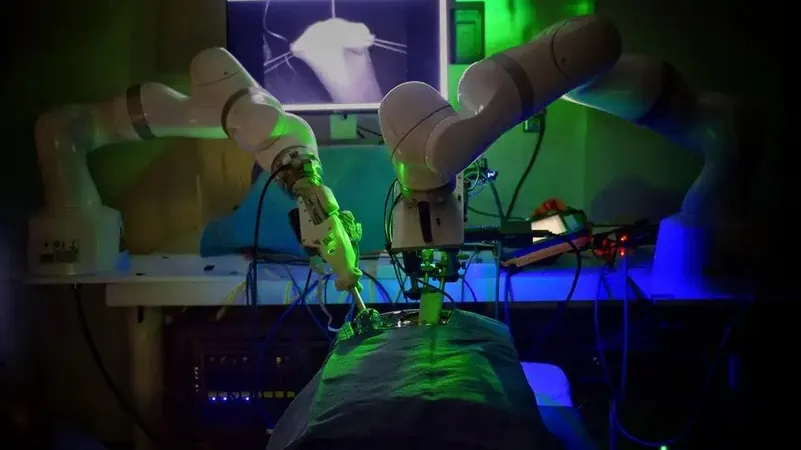
Revolutionary AI Robots on the Brink of Autonomous Surgery: Are We Ready?
2024-12-30
Author: Yan
Introduction
In an exciting development that bridges technology and medicine, researchers have made incredible strides in training surgical robots to perform operations autonomously by learning from video footage. This innovation, spearheaded by teams from Johns Hopkins University and Stanford University, draws on advanced AI techniques reminiscent of those powering conversational models like ChatGPT.
Advancements in Autonomous Surgery
Using a vast dataset of recorded surgical tasks performed by human-controlled robotic arms, this research aims to automate the intricate process of surgery by enabling robots to imitate and refine their movements. Notably, these robots have progressed to manipulate surgical instruments — such as needles — effectively, tie intricate knots, and suture wounds independently. Remarkably, the robots are not just mimicking; they are learning to correct their mistakes, such as retrieving a dropped needle, a significant leap towards true autonomy in surgical procedures. Researchers are now moving towards complex tests involving complete surgeries on animal cadavers, a critical step before human application.
Historically Positive Outcomes
Historically, robotic assistance in surgeries has demonstrated tremendous benefits. Highlighted by the viral “surgery on a grape” phenomenon in 2018, robotic arms have showcased unparalleled precision in procedures. In fact, over 876,000 robot-assisted surgeries were recorded in 2020, with robotic instruments reaching the most inaccessible areas of the human body while remaining steady and free from tremors.
Skepticism and Concerns
Yet, this leap into autonomous surgery has raised eyebrows among skeptics. Critics argue that while AI, like ChatGPT, can mimic behaviors, it lacks true understanding. The vast universe of medical conditions, each with its unique presentations, presents a daunting challenge: what if an AI system encounters a scenario it has not been trained for? The risk associated with rapid, unmonitored actions in surgery could have catastrophic consequences.
Regulatory and Oversight Challenges
Moreover, any surgical robots intended for autonomy will require stringent oversight, potentially needing approval from the Food and Drug Administration. Currently, many AI applications in healthcare do not undergo the same rigorous checks, relying instead on medical professionals to validate outputs generated by AI, a system that may be flawed due to human oversights, especially in busy clinical environments.
Broader Implications for High-Stakes Industries
The challenges don't stop at individual incidents of medical mishaps. The parallels with other high-stakes industries, such as military applications of AI, where misidentification and lack of proper checks have led to severe outcomes, are concerning. Instances where soldiers have launched attacks based solely on AI predictions without thorough verification raise alarms about the overall dependence on AI technology without human oversight.
Liability and Ethical Considerations
Healthcare carries the gravitas of life and death, meaning any incorrect diagnosis or surgical error could have profound ramifications. The question of liability looms large: who will be responsible when AI systems falter?
Expert Opinions and Future Considerations
Experts in the field, including leaders from renowned surgical programs like the University of Miami’s robotic surgery division, are voicing caution, acknowledging the potential of these advancements while also highlighting the indispensable need for thorough oversight and ethical considerations.
Conclusion
As we stand on the brink of a potentially revolutionary paradigm in surgery, one cannot help but ask: Are we ready to let robots take the operating room stage, or have we leaped too far too soon? The future of automated surgery promises immense benefits, but it also demands careful navigation of the ethical and operational challenges ahead.


 Brasil (PT)
Brasil (PT)
 Canada (EN)
Canada (EN)
 Chile (ES)
Chile (ES)
 Česko (CS)
Česko (CS)
 대한민국 (KO)
대한민국 (KO)
 España (ES)
España (ES)
 France (FR)
France (FR)
 Hong Kong (EN)
Hong Kong (EN)
 Italia (IT)
Italia (IT)
 日本 (JA)
日本 (JA)
 Magyarország (HU)
Magyarország (HU)
 Norge (NO)
Norge (NO)
 Polska (PL)
Polska (PL)
 Schweiz (DE)
Schweiz (DE)
 Singapore (EN)
Singapore (EN)
 Sverige (SV)
Sverige (SV)
 Suomi (FI)
Suomi (FI)
 Türkiye (TR)
Türkiye (TR)
 الإمارات العربية المتحدة (AR)
الإمارات العربية المتحدة (AR)